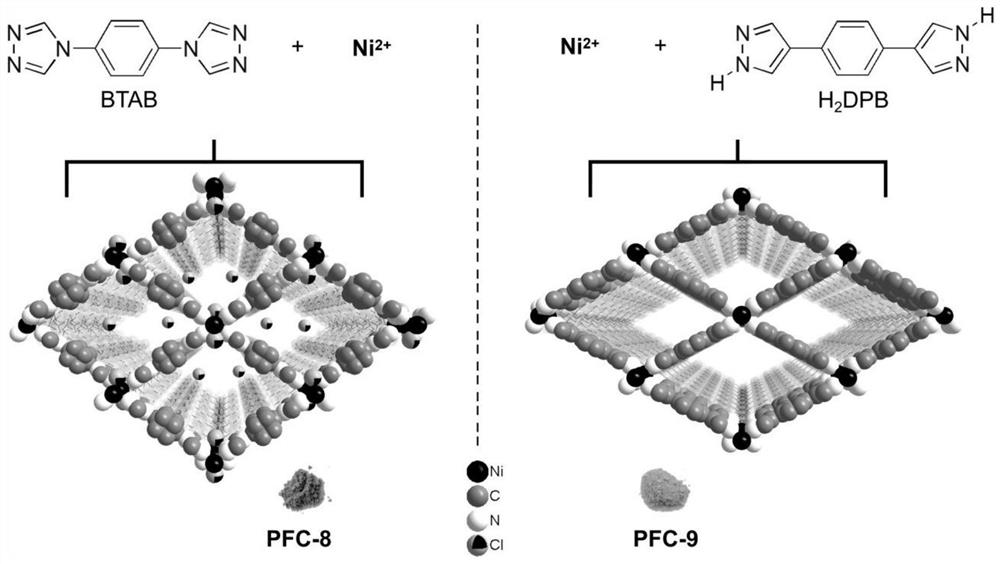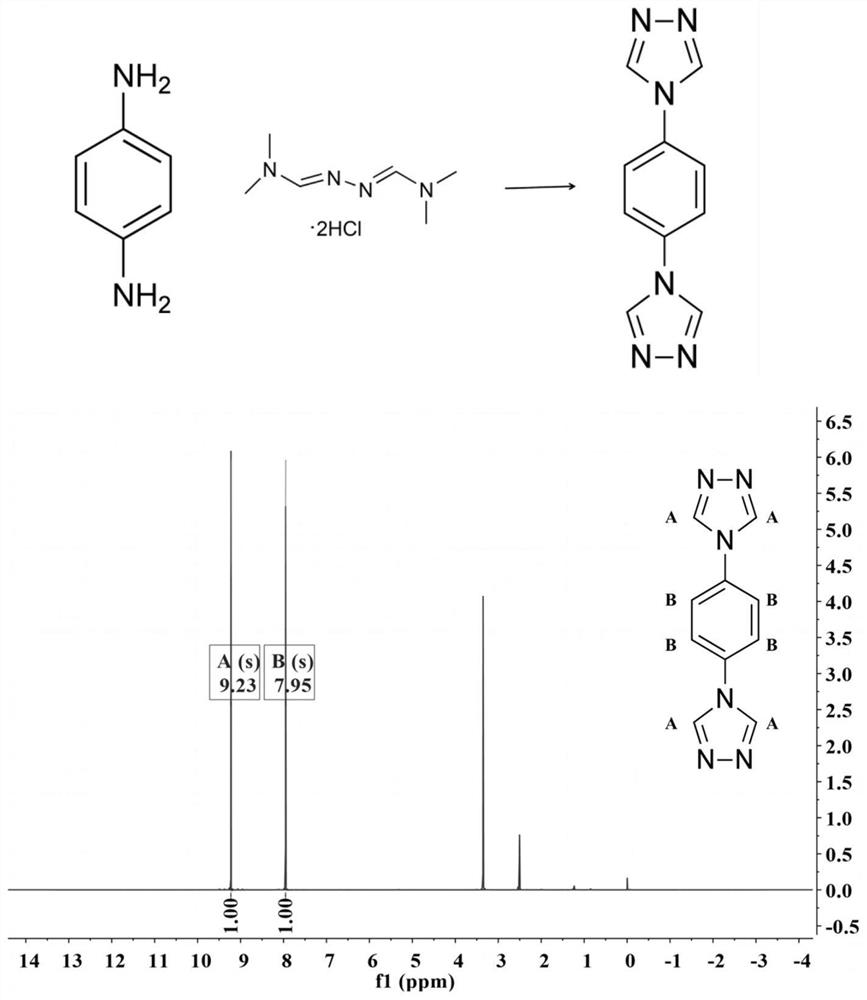Metal-organic framework materials based on heteroaryl functional group ligands and their preparation methods and applications
A technology of metal-organic frameworks and ligands, applied in non-metallic elements, chemical instruments and methods, organic compounds/hydrides/coordination complex catalysts, etc., can solve the problem that MOFs cannot exist stably and stability is difficult to be guaranteed, etc. problem, to achieve the effect of excellent catalytic hydrogen production of formic acid, good ion exchange capacity, and simple preparation method
- Summary
- Abstract
- Description
- Claims
- Application Information
AI Technical Summary
Problems solved by technology
Method used
Image
Examples
Embodiment 1
[0074] Example 1 Synthesis of triazole-based metal-organic framework (PFC-8)
[0075] 114 mg of nickel chloride hexahydrate were dissolved in 4 mL of aqueous solution, and the solution was sonicated for 2 minutes. 66 mg of 1,4-bis(4hydro-1,2,4-triazol-4-yl)benzene (BTAB) was dissolved in 14 mL of DMF solution with sonication for 10 minutes. Then, the two solutions were mixed uniformly, and then 3 mL of triethylamine was added to dissolve by ultrasonic for 15 minutes. Finally, the prepared 21 mL mixture was equally divided into seven 10 mL standard glass vials (3 mL each) and sealed with rubber gasketed caps. The bottle was then left to stand at 130°C for 16 hours. Then the obtained solid was washed twice with a mixed solution of 12M HCl and DMF in a volume ratio of 2:1, and finally washed with acetone three times to obtain PFC-8. The X-ray diffraction pattern is as follows figure 2 (a), the SEM image is shown in Figure 5 (a) and (b).
Embodiment 2
[0076] Example 2 Synthesis of dinitrogen-based metal organic framework (PFC-9)
[0077] Take 1,4-bis(1hydro-pyrazol-4-yl)benzene (H 2 DPB) 105 mg was dissolved in 15 mL of DMF and sonicated for ten minutes. The solution was then placed in a sealed glass bottle and placed in a 90°C oven to preheat to dissolve completely. Then take it out and add 125 mg of nickel acetate tetrahydrate while it is still hot, stir evenly, and then sonicate for 10 minutes. The resulting solution was then transferred into five 10 mL standard glass vials (3 mL each). The vial was placed in an oven at 120°C for 24 hours. The obtained brown solid powder is washed three times with DMF and acetone to obtain PFC-9, and the X-ray diffraction pattern is as follows figure 2 (c).
Embodiment 3
[0078] Example 3 Synthesis of nanoscale triazole-based metal-organic framework (Nano-PFC-8)
[0079] 114 mg of nickel chloride hexahydrate were dissolved in 4 mL of aqueous solution and then sonicated for 2 min. 66 mg of BTAB was dissolved in 14 mL of DMF solution and sonicated for 10 minutes. Then the two solutions were mixed and dissolved by ultrasonic for 15 minutes. Finally, the prepared 18mL mixture was equally divided into six 10mL standard glass vials (each 3mL) and sealed with rubber gasketed caps. The bottle was then left to stand at 120°C for 16 hours. The obtained solid was then washed twice with a mixed solution of 12M HCl and DMF in a volume ratio of 2:1, and finally three times with acetone. The particle size of Nano-PFC-8 nanoscale material is obtained as follows Figure 5 (c, d) show 200 nanometers to 100 micrometers.
PUM
| Property | Measurement | Unit |
|---|---|---|
| particle diameter | aaaaa | aaaaa |
Abstract
Description
Claims
Application Information
 Login to View More
Login to View More - R&D
- Intellectual Property
- Life Sciences
- Materials
- Tech Scout
- Unparalleled Data Quality
- Higher Quality Content
- 60% Fewer Hallucinations
Browse by: Latest US Patents, China's latest patents, Technical Efficacy Thesaurus, Application Domain, Technology Topic, Popular Technical Reports.
© 2025 PatSnap. All rights reserved.Legal|Privacy policy|Modern Slavery Act Transparency Statement|Sitemap|About US| Contact US: help@patsnap.com



